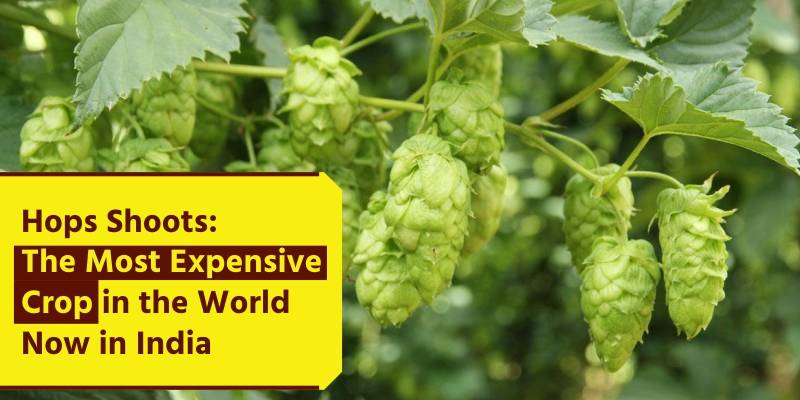Agriculture is the foundation sector for most of the manufacturing industries in the world. India is the land of agriculture and farmers in India are very excited to try new things on their farms. Nowadays the most expensive crop in the world, Hops Shoots cultivation in Bihar is the most discussed subject in India.
Hops are the flowers which are also called seed cones or strobiles of the hop plant. Hop Plant which has the botanical name of Humulus lupulus, a member of the Cannabaceae family of flowering plants. KhetiGaadi is one stop solution for farmers.
Hop shoots are utilized fundamentally as a bittering, seasoning, and stability specialist in beer, to which, notwithstanding harshness, they give a flower, fruity, or citrus flavors and smells.
Hops are additionally utilized for different purposes in different refreshments and medication. The Hop plants have separate female and male plants.
Just female plants are utilized for production purposes. The Hop plant is an energetic, climbing, herbaceous lasting, normally prepared to grow up strings in a field called a Hopfield, Hop Shoots garden in the South of England, or Hops Shoots yard in the West Country and the US when developed financially.
Various assortments of Hops are developed by farmers around the planet, with various kinds utilized for specific styles of beer.
The previously archived utilization of hops in the beer industry is from the ninth century, however, Hildegard of Bingen, after 300 years, is frequently referred to as the soonest recorded source.
Before this period, brewers utilized a gruit, made from a wide assortment of severe spices and blossoms including dandelion, burdock root, marigold, horehound, ground ivy, and heather.
Hops shoots are additionally utilized in preparing for their antibacterial impact over less attractive microorganisms and for implied benefits including adjusting the pleasantness of the malt with harshness and an assortment of flavors and aromas.
Historically, conventional spice mixes for brews were accepted to have been deserted when beers made with hops were seen to be less inclined to spoilage.
History of Hops Shoots
The initially reported Hops development was in 736, in the Hallertau district of present-day Germany, albeit the main notice of the utilization of Hops in the beer industry in that nation was 1079.
However, in the will of Pepin the Short, the father of Charlemagne, Hops gardens were left to the Cloister of Saint-Denis in 768.
Not until the thirteenth century did Hops start to begin compromising the utilization of gruit for seasoning.
Gruit was utilized when the honorability exacted charges on Hops. Whichever was burdened made the brewer at that point rapidly change to the other.
In Britain, Hop Shoots Beer was first imported from Holland around 1400, yet Hops were denounced as late as 1519 as a devilish and vindictive weed. In 1471, Norwich, England, prohibited utilization of the plant in the blending of brew was the name for aged beers bittered with Hops.
In Germany, utilizing Hops was likewise a strict and political decision in the mid-sixteenth century.
There was no duty on Hops to be paid to the Catholic church, dissimilar to on gruit. Thus the Protestants favored Hop Shoot beer.
Hops utilized in England were imported from France, Holland, and Germany with import obligation paid for those; it was not until 1524 that Hops was first filled in the southeast of England when they were presented as a rural yield by Dutch farmers.
Accordingly, in the Hops business, there are numerous words that initially were Dutch words. Hops were then developed as far north as Aberdeen, close to breweries for the accommodation of infrastructure.
In England, there were numerous protests over the nature of imported Hops shoots, the sacks of which were frequently debased by stalks, sand, or straw to build their weight.
Accordingly, in 1603, King James I endorsed an Act of Parliament prohibiting the training by which the Subjects of this Realm have been of late years mishandled &c. to the Value of £20,000 yearly, other than the Danger of their Health.
Hops development was started in the present-day United States in 1629 by English and Dutch farmers. Before preclusion, development was principally revolved around New York, California, Oregon, and Washington state.
Issues with fine buildup and wool mold crushed New York’s creation by the 1920s, and California just delivers Hops on a little scale. Hops bars were utilized before the current apparatus was developed to make the openings for the Hops shafts.
Worldwide Production of Hops Shoots
Hops Shoots cultivation is amassed in soggy temperate environments, with a significant part of the world’s creation happening close to the 48th equal north.
Hops plants favor similar soils as potatoes and the main potato-developing states in the United States are likewise significant Hops Cultivating areas; notwithstanding, not all potato-developing zones can create great Hops normally: soils in the Maritime Provinces of Canada, for instance, come up short on the boron that Hops prefer.
Historically, Hops were not filled in Ireland, however, were imported from England. In 1752 in excess of 500 tons of English Hops Shoots were imported through Dublin alone.
Significant Creation Habitats in World
- Hallertau in Germany,
- Žatec (Saaz) in the Czech Republic Yakima (Washington)
- Willamette (Oregon) valleys
- western Canyon County
- Idaho
- Kent (UK)
- Herefordshire (UK)
- Worcestershire (UK)
Cultivation of Hops
Even though Hops are filled in the majority of the mainland United States and Canada, the development of Hops for business creation requires a specific climate.
As Hops are a climbing plant, they are prepared to grow up lattices produced using strings or wires that help the plants and permit them fundamentally more prominent development with a similar daylight profile.
Along these lines, the energy that would have been needed to assemble primary cells is likewise liberated for crop growth.
The Hops plant’s multiplication technique is that male and female blossoms create on discrete plants, albeit incidentally, a prolific individual will create which contains both male and female flowers.
Because pollinated seeds are unwanted for fermenting brew, just female plants are filled in Hops fields, consequently forestalling fertilization.
Female plants are proliferated vegetatively, and male plants are separated if plants are developed from seeds.
Hops Shoot plants are planted in crop spacing around 7 to 8 ft separated. Each spring, the roots send forward new bines that are fired up strings from the beginning of an overhead lattice.
The cones develop high on the bine, and before, these cones were picked by hand.
Gathering of Hops shoots turned out to be significantly more proficient with the innovation of the mechanical Hops separator, protected by Emil Clemens Horst in 1909.
Harvesting of Hops
Harvest draws close to the furthest limit of summer when the bines are pulled down and the blossoms are taken to a hop house or oast house for drying.
Hops Shoots houses are two-story structures, of which the upper story has a slatted floor covered with burlap.
Here the blossoms are spilled out and raked even. A warming unit on the lower floor is utilized to dry the Hops. At the point when dry, the Hops are moved to a press, a tough box with an unclogger.
Two long bits of burlap are laid into the Hops press at right points, the Hops are emptied in and compacted into bales.
Hops Cones Contents
Hop cones contain various oils, for example, lupulin, a yellowish, waxy substance, and oleoresin, that gives flavor and fragrance to beer.
Lupulin contains lupulone and humulone, which has anti-toxin properties, stifling bacterial development preferring brewer’s yeast to develop.
After lupulin has been separated in the blending cycle the papery cones are disposed of.
Points That Make Hops Valuable
- Preparation of Beer
- Used in Herbal Teas
- Used in Soft Drinks.
- Hops Used in Cooking
- Young Shoots Are Edible
- Cooked Like Asparagus
- Used for Anxiety, Restlessness, And Insomnia
- Hops Pillow Used for Sleeplessness
- Used in Hormone Replacement Therapy
- Used in Menstruation-Related Problems
Nowadays agriculture is booming in different sectors including different flora and fauna.Recently, the interesting hoop shoot crop is in the major talks amongst the farmers.
With specific style and more specific in performance this kind of crop is known to be the most expensive and provides various benefits to the farming system.
This kind of crop is used for several purposes in making medicinal herbs, beers as it is fruity, flowery, and smells good. So, a small crop known as Hop Shoots from Bihar has several usages for farming in larger varieties.
Hop Shoots is the most expensive crop in the world. Cultivation of Hops crop in India opens a new door for our small farmers. The climate in India, Soil in India is suitable for Hop Shoots crops like the Potato crop. If You want to keep yourself updated in the agricultural sector, then Download KhetiGuru Mobile Application.
Visit our page for more information about Tractor, Agricultural implements, Tractor Price, Tractor Videos, and Tractor Games.




